I greatly enjoy keeping puffers because of their cartoon-like movements and appearance, permanent smile, social interaction with their outside world, and most of all, their uniqueness! I appreciate fish that are unusual in the hobby, that present a challenge in the aquarium for the more experienced aquarist and the puffer fish fits the bill. It is one of the most satisfying feelings for me to “get it right” with such a sensitive and unique fish!
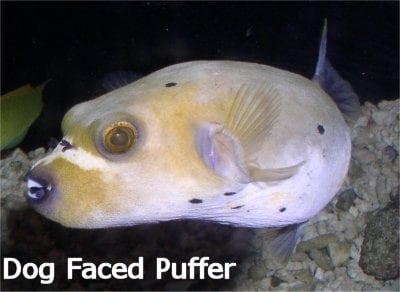
There are three different types of puffer fish. Those that live in fresh water, such as in ponds, the upper reaches of rivers, lakes, and streams; in the brackish waters of river estuaries, deltas, the lower reaches of a river and mangrove-type habitats or salt water (marine), that is, living in the ocean. The brackish water puffers require a lower dosage of marine salt mix, while the marine varieties require a high level of specialized marine mix salt. Most of the species seem to reside in true marine conditions, though there are a few, which are strictly fresh water puffers. In fact, most species of brackish water puffers can actually be kept in full marine conditions.
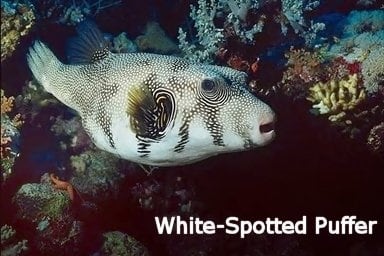
Examples of fresh water puffers include the Dwarf (or Pygmy) Fresh Water, T. fahaka, Red Eye, Brazilian Fresh Water, Spotted Congo and Mbu Puffers. Brackish water examples include the Green Spotted and Figure Eight Puffers. There are many marine types, including the Valentini (aka Saddleback), Dog Face, Sharp Nose and Stars and Stripes Puffers as well as the infamous Blowfish.
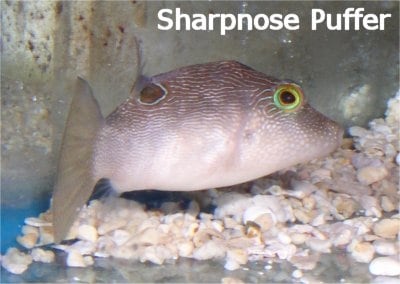
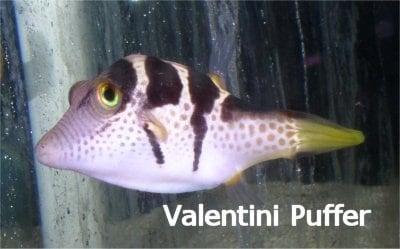
Puffers are a sensitive, scale-less, and specialized fish. They require excellent water conditions and therefore, are not a good fish for the beginning fishkeeper. The Dwarf Fresh Water Puffers are a bit more forgiving because they do not require a specialized pH, but you will have more success with puffers if you first gain some general fishkeeping experience, especially in the area of maintaining excellent water quality.
Most smaller puffers require at least a 15-20 gallon aquarium. However, the Dwarf Fresh Water Puffer may be kept as a solitary puffer in an aquarium as small as 5 gallons, providing that the water quality is carefully monitored. The large Tetraodon fahakas and puffers of like size, require a minimum tank size of 55 gallons. A rule of one inch of your fish’s body length per 1.5-2 gallons of water as a minimum is a general rule for stocking puffers in an aquarium.
There are many species of puffer fish that are very aggressive and territorial, such as the Red Eye Puffer, so if you keep your puffer with any other fish (other puffers included), then do so at your own risk! Fin nipping, predatory behavior, mutilation and even death can result.
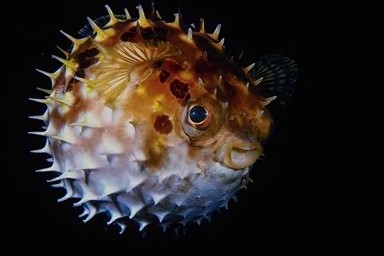
When trying to keep puffers with other fish, it is essential to provide plenty of space, hiding holes and decorations, which will allow your puffer to create its’ own territory and feel safe and non-threatened in its’ environment.
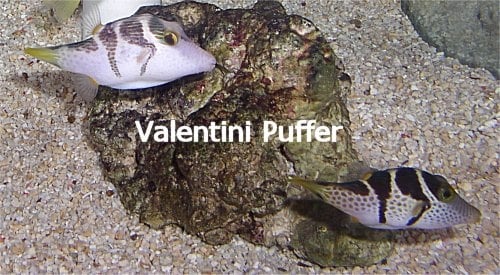
Most water out of one’s tap is suitable for keeping puffers. Using a high quality multi-purpose water conditioner such as Prime or AmQuel and NovAqua in combination, is best. These conditioners detoxify chloramines, chlorine, ammonia, heavy metals and benefit the fish’s slime coat.
If setting up a brackish or salt water tank, be sure to use marine mix salt, and not simply aquarium salt, because the aquarium salt lacks the minerals necessary for your puffer’s good health. Marine mix salt provides these essential minerals, which raise the water’s hardness and pH. I sometimes also add crushed oyster shells or crushed coral to increase my water’s hardness and pH.
In order to make brackish or salt water, the following items are required:
- Marine salt
- Hydrometer
- Tap water
- Water conditioner (Prime or AmQuel/NovAqua)
- Bucket
A hydrometer is a relatively inexpensive device that is easy to use and measures the specific gravity (s.g.) of your water. The term “specific gravity” refers to the ratio of the density of the water that you are testing as compared to the density of pure water. Pure water is defined as having a specific gravity of 1.000, so water with an s.g. of 1.020 is 2% more dense than pure water. If your water has lots of dissolved metals in it, it might have an s.g. of 1.010 or more, even before any salt is added. However, for the purpose of aquariums, one usually ignores other solids and assumes that the specific gravity value is due to the salt alone.
My recipe for mixing up brackish water is 1.5 tablespoons of marine salt for every one gallon of water and this keeps the specific gravity (s.g.) at about 1.015-1.017. Mix the marine salt, water and water conditioner at the proper dosage in the bucket. Be sure that the bucket that you are using is dedicated for the purpose of mixing up salt water and that it has never had soap or other chemicals in it. With brackish water set-ups, the salinity does not need to be constant. In fact, a bit of swing back and forth is good because this mimics the natural ebb and flow of the tides.
For a salt water aquarium, it is best to pre-mix the marine salt in a large container of water (about 25% of the total tank volume) and test it a couple of times with a hydrometer until a consistent and desired level is reached because some marine salts dissolve at different rates and accuracy is very important with marine tanks. Be sure that the hydrometer measurements in the tank and the container are the same before changing any water. The specific gravity of your salt water should be between 1.020 and 1.025. This water can be kept at the proper temperature by using a separate heater in the container.
It is safest to get a hydrometer to be sure that your specific gravity level stays where it should be for your puffer’s good health, and not so high that it endangers your fish. A hydrometer also comes in very handy if one of your puffers becomes ill, because besides ruling out the usual water parameter problems, such as drastic changes in pH and measurable ammonia and nitrite, you must also rule out a specific gravity or salinity problem.
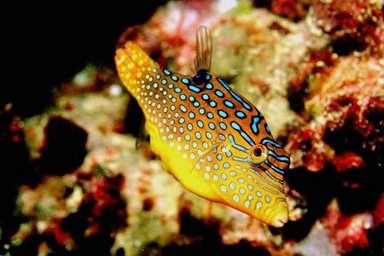
Currently, there is controversy among hobbyists as to what the true salinity (i.e. the concentration of salt in the water) requirements are of some puffer fish. The Figure Eight Puffer is one example of where there is great disagreement. Some hobbyists feel that the Figure Eight Puffer is truly a brackish fish, while others claim that the addition of salt with them is a mistake. I believe that a very low specific gravity, say 1.008 or so, is necessary, but higher concentrations should be avoided. There is less debate surrounding the Green Spotted Puffer. Many fish/pet stores sell this fish as a fresh water puffer. However, in my experience, the addition of marine salt to a Green Spotted Puffer’s environment greatly improves its’ health. In addition, there are others, who feel that this fish is truly a marine animal in adulthood, and so, keep it in marine conditions. I have seen wholesalers keeping these fish in purely fresh water and they did very poorly, often contracting Ich. I tried for a long time to keep Green Spotted Puffers in a tank with only using regular aquarium salt. I had at least two puffers that “wasted” away and one that developed Ich. All three perished. When I switched to a larger tank and began using marine mix salt and increased my water change amount and frequency, to date, I have yet to see any illness in the three Green Spotted Puffers that I have kept for the last year. As a result, I believe that in order to maintain this fish in a healthy state, that the Green Spotted Puffer should be kept in brackish conditions, having a minimum specific gravity of 1.010 along with a high pH of 7.5-8.2 by using marine mix salt.
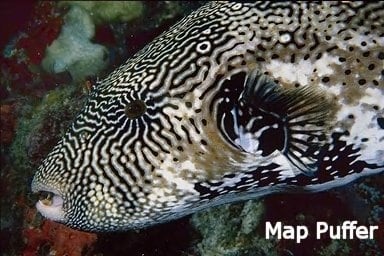
Frequent water changes (e.g. 25% every week) are needed to maintain excellent water conditions. The water temperature requirement for most puffers is 78-80*F (25.5-26.5*C), though some marine puffers may require higher temperatures. When water naturally evaporates from a tank between water changes, the salt does not evaporate with it. With evaporation, the salinity of your water will therefore increase. I compensate for this during my water changes by keeping track of the gallons that I remove, adding adequate marine salt for those gallons removed, and then adding extra fresh water (without salt) to replace the evaporation.
A varied diet high in protein is healthiest for a puffer. A healthy puffer should be active, curious, and have a nice round jolly belly! Their diet consists mainly of mollusks and crustaceans. There are many foods that your puffer may accept, including frozen krill, crab, prawn, squid, clam, mussel, cockle, bloodworms and brine shrimp. If you have a large puffer and you attempt to feed him baby or even adult brine shrimp, he may not be interested in such small food. The same applies when trying to feed a large piece of food to a small puffer. Instead, cut the food down to size. Many species of puffer will not take flake or dried food, though on occasion they will.
Puffers will often mangle or eat plants. They often ruin plants as they are attempting to remove snails from them. An exception however is the Dwarf Fresh Water Puffer (T. travancorius), who tends to be well behaved in a planted tank.
Interestingly, puffers tend to swim without the use of their tails, which you find instead curled up next to them!
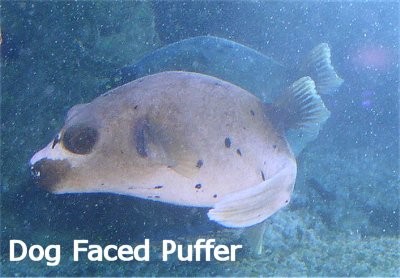
Puffers have a “beak” that is formed by two “teeth” above and two below, which are “fused together”. In fact, the word Tetraodontidae means “four teeth”. It is important that you provide your puffer with hard items, with which to keep its’ teeth nicely trimmed down. Such items that your puffer can bite and chew on are harder foods (e.g. snails), aquarium-safe terra cotta pots, non-pH-altering driftwood and cuttle bone. The shell of the Malaysian Trumpet snail may be too hard for a puffer’s beak and should be avoided. Pond and Ramshorn snails work nicely though.
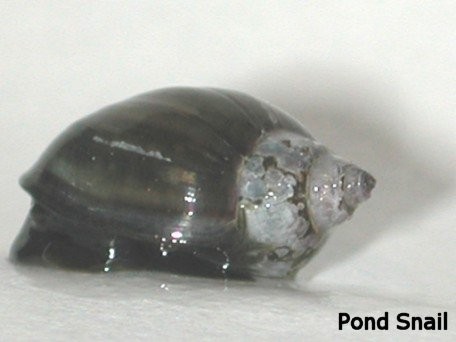
Puffers can nip, but generally they are too timid to do so. In fact, mine get so frightened during water change time that they try to jump! Yet, some types, such as the Spiny Puffer, can cause deep gashes when they bite!
Most puffers, including the infamous Blowfish, contain a poison termed “tetrodotoxin”. This poison is stored in the liver and reproductive organs of a puffer. In Japan, there are those, who in trying to prove their “manhood”, eat a puffer fish called “Fugu” and the chef must prepare the fish exactly right or the person will end up eating fish contaminated with the tetrodotoxin, which may lead to death. While the handling of your puffer should never really be necessary, if, for some unforeseen reason you must handle it, do so with caution, because if it inflates, then its’ spines may puncture your skin, introducing its’ poison into your body. It may be safest to anesthetize your fish before handling it.
Puffers do puff! When a puffer inflates, it fills itself with so much water that it stretches out its’ skin and its’ spines become erect. A puffer’s skin is very stretchy and it and the stomach are made in layers of folds, like an accordion, which lends them to being stretched. The water that is taken in then fills its’ stomach and the puffer will enlarge until several times its’ normal size, which makes it a more problematic prey to kill.
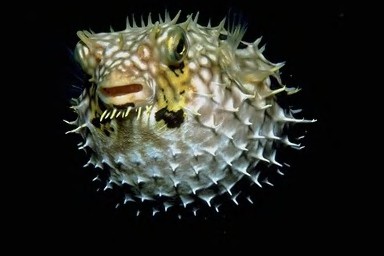
The Spiny Puffer (Diodon holocanthus) becomes so enlarged that its’ stomach volume increases by one hundred-fold and its’ body becomes a large, rigid, round ball, marked by its’ spines sticking out all over!
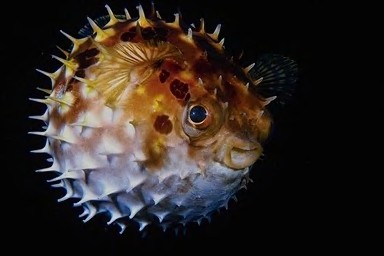
However, having a puffer inflate should be avoided at all costs because the puffer may accidentally swallow air. If the fish swallows air, it can then have buoyancy problems and since these fish are so sensitive, this stressor may cause it to stop eating. Also sometimes, the deflation process is difficult. If your puffer does inflate, you should understand that this display is a last ditch-type of defense mechanism for it, and it is severely stressful to the fish, not to mention its’ owner! It reduces the life span of the puffer and can cause circulation problems because the high internal pressure caused from the water may impair normal blood flow and the drastic change in stomach size may lead to digestive difficulties. Stressing out a fish, may lower its’ immune system, which can then lead to disease. You should work at identifying and preventing any stressors, which cause this behavior.
Leave a Reply